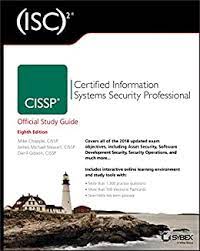

Domain 7 Exam.
A minimum of 70% is required to pass.
#1. Which formulas are used in a Business Impact Analysis (BIA) assessment?
#2. One approach to alternative off-site facilities is to establish a reciprocal agreement. Which of the following describes the pros and cons of a reciprocal agreement?
〇:Can be the cheapest of the off-site options, but can create many security problems due to mixed operations.
Reciprocal agreements, also called mutual aid, mean that Company A agrees to allow Company B to use its facilities if Company B suffers a disaster, and vice versa. While this is a less expensive way to move than other off-site alternatives, it is not always the best choice. In most environments, the facility has reached its limits regarding the use of space, resources, and computing power. To allow different firms to come in and operate out of the same store could be detrimental to both firms. The stress of both companies working in the same environment can cause tremendous levels of tension. If that did not work out, it would provide the only short-term solution. Configuration management could be a nightmare, and mixing operations could result in many security problems. Reciprocal agreements have been known to work well for certain companies, such as newsprint. These firms require very specific technology and equipment that is not available through any subscription service. For most other organizations, reciprocity agreements are, at best, generally a secondary option for disaster protection.
×:Fully set up and ready to operate within a few hours is the most expensive of the off-site options.
This is a description of a hot site.
×:Inexpensive option, but takes the most time and effort to get up and running after a disaster.
Explanation for cold sites.
×:A good alternative for companies that rely on proprietary software, but regular annual testing is usually not available.
This is incorrect as it describes with respect to companies that depend on proprietary software. Having proprietary software in a shared space with other vendors is basically undesirable from the standpoint of license agreements involved.
#3. Which of the following is not a common component as a step to change configuration management?
A structured change management process must be established to direct staff to make appropriate configuration changes. Standard procedures keep the process under control and ensure that it can be implemented in a predictable manner. Change management policies should include procedures for requesting changes, approving changes, documenting, testing and viewing changes, implementing, and reporting changes to management. The configuration management change control process is not typically associated with service level agreement approvals.
#4. In a redundant array in a RAID system, data and parity information is striped across several different disks. What is parity information?
〇:Information used to reconstruct data
RAID can improve system performance by providing fault tolerance to the hard drive and the data it holds. Redundancy and speed are provided by splitting the data and writing it to multiple disks, allowing different disk heads to operate simultaneously to retrieve the requested information. Control data is also distributed across each disk. This is called parity, and if one disk fails, the other disks can work together to recover the data.
×:Information used to create new data
This is incorrect because parity information is not used to create new data, but rather as instructions on how to recreate lost or corrupted data.
×:Information used to erase data
Parity information is not used to erase data. This is incorrect because it is used as instructions on how to recreate lost or corrupted data.
×:Information used to construct data
Parity information is not used to create data. Incorrect because it is used as instructions on how to recreate lost or corrupted data.
#5. Which RAID configuration always provides redundancy?
#6. You are the security administrator for a large retail company. Their network has many different network devices and software appliances that generate logs and audit data. At one point, your staff is trying to determine if any suspicious activity is taking place in the network. However, reviewing all the log files is burdensome. Which of the following is the best solution for your company in this case?
〇:SIEM
Many organizations have implemented security event management systems, called Security Information and Event Management (SIEM) systems. They attempt to correlate log data collected from various devices (servers, firewalls, routers, etc.) and provide analysis capabilities. They also have solutions with networks (IDS, IPS, anti-malware, proxies, etc.) that collect logs in various proprietary formats that require centralization, standardization, and normalization. Therefore, the correct answer is SIEM.
×:Intrusion Detection System
Intrusion Detection System (IDS, Intrusion Detection System) is a mechanism that monitors the system and leads to passive actions. It does not have the ability to collect and analyze logs.
×:SOAR
SOAR (Security Orchestration, Automation and Response) is a technology that enables efficient monitoring, understanding, decision-making and action on security incidents. It may be fulfilled by SOAR through intrinsic cause analysis, but it is not a solution used for the purpose of identifying if suspicious activity is taking place in the network.
×:Event correlation tools
The term “event correlation tool” does not exist, but may be a feature of a SIEM.
#7. Which of the following adequately describes parallel testing in disaster recovery testing?
〇:Ensure that some systems are executed at the alternate site.
Parallel testing compares how some systems run at the alternate site and how the results are processed at the primary site. This is to assure that systems run at the alternate site and does not affect service productivity.
×:All departments will be sent a copy of the disaster recovery plan for completeness.
This alternative is incorrect because it describes a checklist test.
×:Representatives from each department meet to validate the plan.
This option is incorrect because it describes a structured walk-through test.
×:The normal operation system is taken down.
This option is incorrect because it describes a full interruption test.
#8. Which of the following technologies can be used to logically combine physically disparate groups of systems and help provide immunity to failure while also helping with scalability?
〇:Clustering
Clustering is a fault-tolerant server technology in which servers are redundantly analogous. A server cluster is a group of servers that can be logically interpreted by users as one server and managed as a single logical system. Clustering provides availability and scalability. It helps to provide immunity to this group, physically distinct systems and failure and improved performance.
The problem statement is phrased in a difficult sentence. It would be difficult to derive the exact specific words from the phrase “logically coupled with a physically distinct group of systems.” In such questions, it is useful to use a process of elimination to derive options from the words that would be the point of the question. From the latter part, “technology that helps provide immunity to failure while also helping with scalability,” we can see that it is something that is both fault-tolerant and scalable. Fault tolerance alone does not narrow down the choices, but in terms of scalability features, clustering falls into this category. Therefore, the correct answer is “clustering.
×:Disk dupe
There is no such term. When presented with a seemingly incomprehensible sentence, you may consider the possibility that it is a word you probably do not know, given the time limit.
×:RAID
RAID (Redundant Array of Independent/Inexpensive Disks) is a technology for operating multiple hard disks as a single hard disk. It has a mechanism to improve physical redundancy by how the data to be recorded is written to the hard disks. This is not a technology system that ensures scalability.
×:Virtualization
Virtualization is a technology that makes it appear as if multiple operating systems are running on the system. Or, it is an environment that enables the construction of a real environment through simulation-like operations surrounding them. While virtualized environments allow for the construction of environments that provide fault tolerance and scalability, they do not match the operation of logically combining them with physically different groups of systems.
#9. Which of the following backup types does NOT clear the archive bit of the Windows system?
Archive bits are those that have been updated since the previous backup point in time. Full backups are full backups, so there is no need to be aware of where changes have occurred. Incremental backups also do not require awareness of change points because the backup portion is predetermined. Therefore, both clear the archive bit. However, differential backups do not clear the archive bit because only the changed part is known to be backed up.
#10. Which of the following plans would you use to organize information about specific system hardware?
Disaster Recovery Planning (DRP) is the process of creating short-term plans, policies, procedures, and tools to enable the recovery or continuation of critical IT systems in the event of a disaster. It focuses on the IT systems that support critical business functions and how they will be restored after a disaster. For example, it considers what to do if you suffer a distributed denial of service (DDOS) attack, if your servers are compromised, if there is a power outage, etc. BCP is more focused on what should happen and does not necessarily include system requirements.
#11. Server cluster configurations are taken for critical applications, but what functions are achieved by this configuration?
Clustering is designed for fault tolerance. It is often combined with load balancing, but they are essentially separate. Clustering can make an operation active/active. On top of that, the load balancing feature handles traffic from multiple servers. Active/passive, on the other hand, has a designated primary active server and a secondary passive server, with the passive sending keep-alives or heartbeats every few seconds.
#12. After a disaster has occurred, an impact assessment must be performed. Which of the following steps is the last one performed in an impact assessment?
〇:Declare the impact and consequences of the disaster.
The final step in the damage assessment is to declare the disaster. After the information from the damage assessment has been collected and evaluated, determine if the BCP actually needs to be activated. The BCP coordinator and team should determine the activation criteria before the disaster occurs.
×:Determine the cause of the disaster.
Determining the cause of the disaster is incorrect as it is the first step in the damage assessment process.
×:Identify resources that need to be replaced immediately.
Incorrect because identifying resources that need to be replaced immediately is not the last step in damage assessment.
×:Determine how long it will take to bring critical functions back online.
Incorrect because determining how long it will take to bring critical functions back online is the second-to-last step in damage assessment.
#13. Which of the following is a structured walk-through test in disaster recovery testing?
〇:Representatives from each department meet and undergo validation.
Structured walk-through testing allows functional personnel to review the plan as it is fulfilled to ensure its accuracy and validity.
×:Ensures that some systems will run at alternate sites.
This is incorrect because it describes parallel testing.
×:Send a copy of the disaster recovery plan to all departments to verify its completeness.
This is incorrect because it describes a checklist test.
×:Take down the normal operation system.
This is incorrect because it describes a full interruption test.
#14. Different levels of RAID determine the type of activity that occurs within a RAID system. Which level of RAID is associated with byte-level parity?
〇:RAID Level 3
RAID redundant arrays provide fault tolerance capability for hard drives and can improve system performance. Redundancy and speed are provided by splitting data and writing it to multiple disks, allowing different disk heads to operate simultaneously to retrieve requested information. At this time, recovery data is also created. This is called parity; if one disk fails, the parity data can be used to reconstruct the corrupted or lost information. Different levels of RAID systems experience different activities that provide fault tolerance or improved performance. RAID level 3 is a method that uses byte-level striping and dedicated parity disks.
×:RAID Level 0
Wrong because only striping occurs at level 0.
×:RAID Level 5
RAID 5 is incorrect because it uses block-level striping and interleaved parity on all disks.
×:RAID Level 10
Level 10 is incorrect because it is associated with striping and mirroring.
#15. You are selecting a site for a new data center and offices. Which of the following is not a valid security concern?
Greenfield is undeveloped land that has not yet been built upon. The perspectives for selecting a site as a data center site include topography, utilities, and public safety.
- Topography refers to the physical shape of the landscape-hills, valleys, trees, streams.
- Utility refers to the degree to which power and internet in the area are reliable.
- Public safety is in terms of how high is the crime rate in the area and how close is the police force.
#16. The team should be involved in the implementation of the business continuity plan. Which team is responsible for initiating recovery of the original site?
〇:Salvage Teams
The BCP coordinator should understand the needs of the company and the types of teams that need to be developed and trained. Employees should be assigned to specific teams based on their knowledge and skill sets. Named leaders, each team must have members and the ability to direct their activities. These team leaders will be responsible not only for ensuring that team goals are met, but also for interacting with each other to ensure that each team is operating properly. The salvage team is responsible for initiating recovery of the original site. They are also responsible for backing up data from the alternate site and restoring it within the new facility, carefully terminating any unforeseen operations, and ensuring equipment and personnel are transported to the new facility.
×:Damage Assessment Team
The Damage Assessment Team is incorrect because it is responsible for determining the extent and severity of damage.
×:BCP Team
Wrong because the BCP team is responsible for creating and maintaining a business continuity plan.
×:Recovery Team
Wrong because the Recovery Team is responsible for getting an alternate site to work and to keep the environment functioning.
#17. Which of the following plans is intended to establish a senior management or post-disaster headquarters?
〇:Continuity of Operations Plan
A continuity of operations plan (COOP) establishes senior management and post-disaster headquarters. It also outlines roles and authorities and individual role tasks.Creating a COOP begins with an assessment of how the organization operates to identify mission-critical staff, resources, procedures, and equipment. Suppliers, partners, and contractors identify other companies with whom they routinely interact and create a list of these companies. Therefore, the correct answer is the Continuity of Operations Plan.
×:Cyber Incident Response Plan
Cyber Incident Recovery is a plan for recovery from a cyber attack.
×:Crew Emergency Plan
A Crew Emergency Plan is a plan for the smooth transition of a facility’s staff to a secure environment.
×:IT Contingency Plan
A contingency plan is a plan that outlines the measures to be taken in the event of an accident, disaster, or other emergency.
#18. Which of the following is NOT a phase of the Disaster Recovery Planning life cycle?
Disaster Recovery Planning includes the Mitigation, Preparedness, Response, and Recovery life cycles.
- Mitigation: Reduces the impact and likelihood of a disaster.
- Prepare: Create programs, procedures, and tools for response.
- Response: follow procedures and how to respond to a disaster.
- Recovery: re-establish basic functionality and return to a full production environment.
#19. Which of the following is most relevant in achieving the objective of securing all evidence and notating it as information to be presented to those who verify it?
〇:Control of the processing and distribution process
An important part of the digital forensic process is to maintain a proper chain of custody of evidence.
The question structure assumes Chain of Custody (Chain of Custody) from “the purpose of securing all evidence and notating it as information to be presented to those who verify it” and selects the one that comes closest to the definition.
×:Reasonable care
Wrong because reasonable care implies performing an activity that a reasonable person would be expected to perform under similar circumstances.
×:Investigation
Incorrect because investigation involves the proper collection of relevant data during the incident response process and includes analysis, interpretation, reaction, and recovery.
×:Motive, Opportunity, Means
Motive, Opportunity, and Means (MOM) is incorrect because it is a strategy used to understand why certain crimes were committed and by whom.

